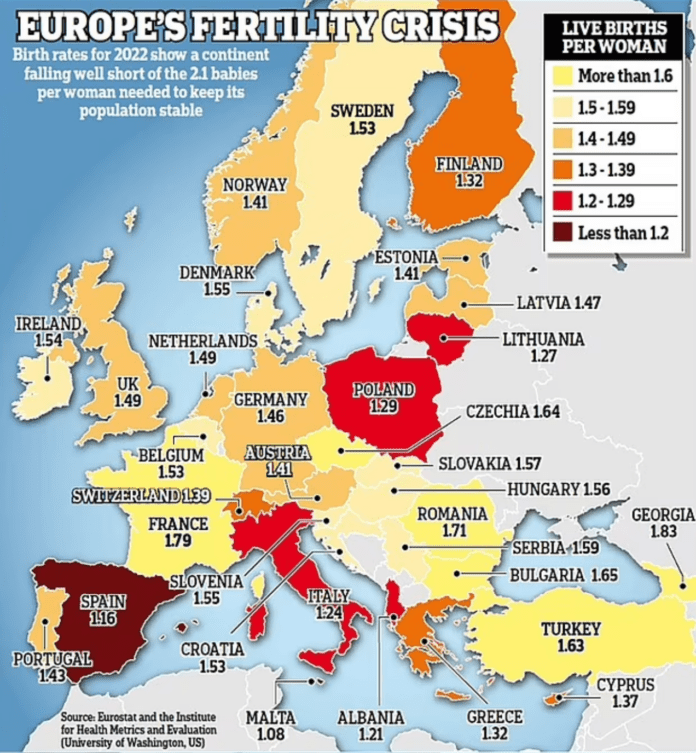Elon Musk recently remarked the Europe is dying due to its fertility crisis. It’s population is facing a significant demographic challenge as birth rates continue to decline across the continent. The latest data from Eurostat paints a stark picture of the EU’s fertility crisis. Generation Z and its successors are facing significant challenges related to declining birth rates and demographic shifts in Europe.
Declining Birth Rates
In 2022, only 3.88 million babies were born in the EU, marking a substantial decrease from previous years. This translates to a crude birth rate of 8.7 live births per 1,000 people, a figure that has been steadily falling over the past half-century. To put this into perspective, the EU’s crude birth rate was 10.5 in 2000, 12.8 in 1985, and 16.4 in 1970.
The decline is even more pronounced when compared to the peak of 6.8 million births recorded in 1964. Since then, the number of live births has been on a downward trajectory, with only brief periods of slight recovery. The COVID-19 pandemic further exacerbated this trend, with births dropping to 4.07 million in 2020, slightly increasing to 4.09 million in 2021, before falling again to the current low of 3.88 million in 2022.
Fertility Rates Across Europe
The total fertility rate in the EU stood at 1.46 live births per woman in 2022, well below the replacement level of 2.1 children per woman needed to maintain a stable population. This rate varies significantly across member states:
- France leads with the highest fertility rate of 1.79 live births per woman
- Romania follows with 1.71
- Bulgaria and the Czech Republic have rates of 1.65 and 1.64 respectively
- At the lower end, Malta (1.08), Spain (1.16), and Italy (1.24) have the lowest fertility rates
Causes and Contributing Factors
Several factors contribute to Europe’s declining birth rates:
- Socio-economic shifts: Increased female participation in the workforce and improved access to contraception have played significant roles.
- Delayed parenthood: The average age of women at first childbirth in the EU is now 29.7 years, with Italian women having their first child at an average age of 31.7 years.
- Economic pressures: Rising housing costs and financial uncertainty have made it more difficult for young people to start families.
- Changing social norms: There has been a de-stigmatization of childlessness and a shift in personal priorities.
Implications for Europe
The consequences of these declining birth rates are far-reaching:
- Population decline: The EU’s population is projected to peak at 449 million in 2026 before declining to approximately 441 million by 2050 and 416 million by 2100.
- Aging population: By 2060, there could be 59 individuals aged 65 and over for every 100 people of working age in the OECD area, up from 30 in 2020.
- Economic challenges: A shrinking workforce could lead to reduced economic growth and increased pressure on pension and healthcare systems. Gen Z faces significant mental and financial stress, with many living paycheck to paycheck
- Social changes: Societies may need to adapt to new family structures and living arrangements, with more young adults living with parents due to financial constraints.
Policy Responses
To address these challenges, policymakers are considering various strategies:
- Family-friendly policies: Improving work-life balance and providing better support for parents.
- Housing initiatives: Making housing more affordable to facilitate family formation.
- Migration policies: Considering more open immigration to offset population decline.
- Economic adaptations: Focusing on increasing productivity and labor force participation to mitigate the effects of a shrinking workforce.
As Europe grapples with this “demographic winter,” the need for comprehensive and innovative policy approaches becomes increasingly urgent. The future prosperity of the continent may well depend on how effectively it can address these demographic challenges and support the aspirations of its citizens to form families.





